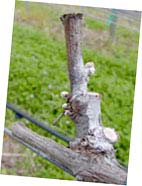Baby talk.

A 2-bud spur with leaves beginning to form.  Eutypa, or deadarm, is a disease that costs California grape and apricot growers about $1.7 billion annually. It is a fungus, spread by rain with the infection entering through pruning wounds. Note the white stains around the pruning wound (lower left below the spur). Recently we started painting pruning wounds with a 30% solution of Dreft© and water.
Eutypa, or deadarm, is a disease that costs California grape and apricot growers about $1.7 billion annually. It is a fungus, spread by rain with the infection entering through pruning wounds. Note the white stains around the pruning wound (lower left below the spur). Recently we started painting pruning wounds with a 30% solution of Dreft© and water.
Along that same line, we don´t paint pruning wounds with heavy duty and expensive fungicides. A recent field study at the University of California showed that a popular brand of baby detergent in a 30% solution was as effective against Eutypa. Ironically it can’t be officially recommended because the baby soap manufacturer hasn’t spent the millions required to have it registered for vineyard use. Our soft approach to chemicals means our vineyards smells of herbs, flowers and earth. We think that shows in the flavors of Navarro’s wines. The 1999 Mendocino Pinot Noir is slightly floral with hints of violets and roses. The mouth is medium full with flavors suggesting strawberry and cherry. There are earthy, mushroom flavors as well and a backbone of toasty oak at a price that can’t be beat.
Gold Medal winner. 1 case limit.

